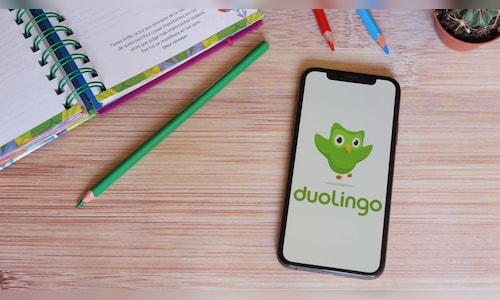The language-learning platform has recognised the immense influence of content creators in engaging audiences and driving brand awareness, particularly in India, where English learning is a significant market.
With a strong presence on Instagram and YouTube Shorts, Duolingo’s India strategy thrives on creator collaborations. Parvez highlighted that the company works closely with its Indian country marketing manager to develop a localised approach that resonates with users. She added that by engaging creators, Duolingo builds authentic connections with its audience and ensures that its content is both culturally relevant and entertaining.
Beyond its creator-driven strategy, Duolingo is also harnessing AI to enhance its social media efforts. While the brand still produces content in-house, AI assists in refining and diversifying its messaging. “Maybe we need joke punch-ups, or we need something to help us be like, ‘Is this funny? Is this not funny?'” Parvez explained. AI allows the team to experiment with different tones and personas, ensuring their content appeals to a broader audience.
Duolingo has long been at the forefront of AI-driven personalised learning. With advancements in generative AI, the company continues to push the boundaries of accessible education. “Our biggest focus is making education accessible and gamifying learning,” Parvez said. The platform has expanded beyond languages into math and music, using AI to create engaging and compelling learning experiences.
Duolingo’s viral success on TikTok — growing from 50,000 to 16 million followers—is a testament to its unique approach to social media. Instead of behaving like a traditional brand, Duolingo positions its mascot, Duo the Owl, as a creator in its own right. “Our biggest competitors were not other language learning apps, but anything that takes our audience’s attention,” says Parvez. Parvez added that Duolingo has made learning fun and engaging by embracing internet culture and satire.
Edited Excerpt from the Interview:
Q: Duolingo has a large presence in India, one of your largest English-learning markets. You’ve always had a social media first strategy out here to try to make people understand that Duolingo exists, and they can use it, and this is what you can do with it. So, could you shed light on your strategy for India?
Parvez:
We have country marketing managers worldwide, and one of our amazing Indian country managers runs the India account. And we always say, like, his strategy obviously lives on Instagram and YouTube shorts, but he also really thrives on, like, engaging creators. And so, for us, what we have seen from the Indian market is just how creators are so essential and crucial to building out our brand and creating genuine connections. Also, English learning is huge in India, so how do we figure out ways to have fun, like course launches, or use people to engage in different ways throughout the various cultures there? And I think creators are at the core of our India strategy.
Q: Could you tell us how you integrate AI and innovation into your social media strategy to make it more exciting and reach more consumers? How are you using AI right now?
Parvez: for us, a lot of it is about figuring out how AI can make it easier and simpler for us. At this point, we still film all of our stuff in-house. We have our creatives for it, but we may need joke punch-ups to help us feel, “Is this funny? Is this not funny? What are different ways that I can write this or talk about this?” And I think AI helps us have that hat on of just thinking differently and not being exactly how Zaria would approach it, but how would like a middle-aged woman from like Wisconsin approach this or so on and so forth. So, getting those different personas to bring it to life in our content has been awesome.
Q: Duolingo has always been at the forefront of using AI for personalised learning. Where do you see this going with the advent of generative AI and many newer technologies?
Parvez: For us, it’s really about just making education accessible, and that’s the biggest thing. How can we keep teaching in ways that are unique and engaging? One of our biggest things is gamifying learning, and we’ve gone from language learning to math to music. So, I think for us, it is just constantly figuring out ways to make it more accessible.
Q: When you started, your followers on TikTok were at about 50,000, and now you’re at 16 million, and it’s gone viral. Everybody talks about it. Duolingo has broken the internet on that front. So, take us through what your strategy was; what was the thinking behind this?
Parvez: For us, the biggest thing was how to be entertaining, and we were looking at it more of Duo as a creator versus a brand. How would a creator show up in this space? And so, we started just creating content that I would want to consume, or like anyone who wants to watch and wants to consume. Our biggest competitors were not other language-learning apps, but it was what caught our attention. So, we built this whole strategy of Duo being a creator himself and being a form of satire that was making fun of the internet and doing trends that you or I would do, but now an owl is doing it. How do you personify something so complex, like learning a language, which is hard, and our job is to make it fun? So, we do that through different avenues of just interacting with culture.
Q: When you came up with this idea, was it difficult to ask the management or tell them that this is what we need to do to break the internet? How did you convince people that this is what we need to do?
Parvez: I think it’s part of our DNA. Duolingo is also testing, learning, and putting their best foot out there. And I feel very lucky it wasn’t this big uphill battle to convince. I always say that when you hire an engineer, you expect them to code. So, when you hire a Social Media Manager, they expect us to create good social content. And we try to create that environment of what we need to do to have the maximum impact. And when we sold the strategy of Duo being a creator, it wasn’t seen as ordinary work; we’re a quirky brand, have silly sentences, and do silly things. So, they’re like, let’s see where it goes. And so, started small and just kept iterating.
Watch the accompanying video for the entire conversation.


